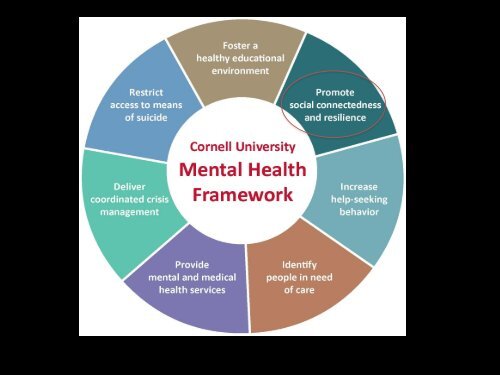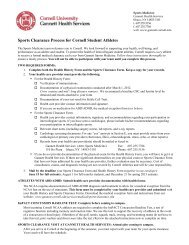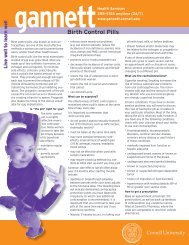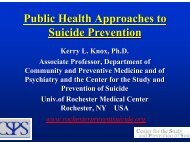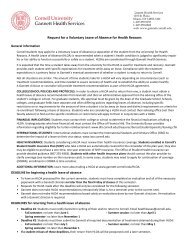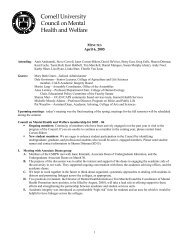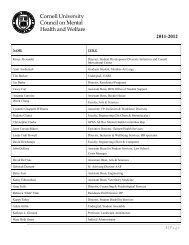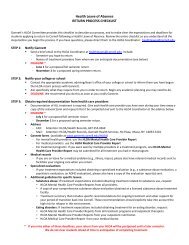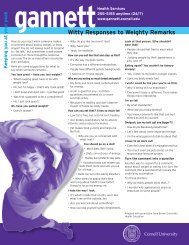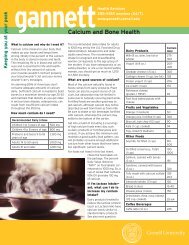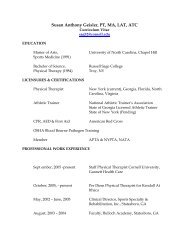Fostering Resilience Model - Gannett Health Services - Cornell ...
Fostering Resilience Model - Gannett Health Services - Cornell ...
Fostering Resilience Model - Gannett Health Services - Cornell ...
Create successful ePaper yourself
Turn your PDF publications into a flip-book with our unique Google optimized e-Paper software.
The <strong>Cornell</strong> Mental <strong>Health</strong> <strong>Model</strong>
Mental <strong>Health</strong> Programmers Work Team<br />
Catherine Thrasher-Carroll<br />
Jan Talbot<br />
Kirsten Post Eynav<br />
Shura Gat<br />
Casey Carr<br />
KiranJit Longaker<br />
Sarah Jones<br />
Amanda Carreiro<br />
Kristyn Bochniak<br />
Janis Whitlock
A framework for building<br />
resilience on college campuses<br />
The Mental <strong>Health</strong> Programmers<br />
Workgroup<br />
<strong>Cornell</strong> University
When we talk about mental health…<br />
The term “mental health” is fluid and generally refers to a range of<br />
psychological and emotional states. For our purposes, mental health refers to<br />
a positive state of psychological and emotional well-being and the conditions<br />
that foster it<br />
Thriving<br />
Mental Illness<br />
Mental illness: any disorder of the mind; the psychological state of someone<br />
who has emotional or behavioral problems serious enough to require<br />
psychological/psychiatric intervention<br />
Thriving: Flourishing, living up to one’s potential (e.g. academic, personal,<br />
social) and experiencing a sense of purpose, life satisfaction and wellbeing
Psychological distress<br />
Of all students:<br />
6% show signs of high psychological distress<br />
35% show some distress<br />
20% Thriving<br />
59% show no distress<br />
Whitlock, et. al., 2011 and in prep; Keyes, 2007
The mental health landscape: What<br />
the data say
The mental health landscape<br />
Rates of mental health challenges among<br />
everyone, particularly youth, are high and<br />
may be increasing (Twenge, 2010; Kessler et. al., 2004;<br />
Guthmnan et., 2010; Gallagher et. al., 2003).<br />
Age of onset for most mental disorders is<br />
18-24 but symptoms often begin earlier<br />
(most common are depression and<br />
anxiety)<br />
Four in ten students say that they have<br />
been unable to function in the past 12<br />
months do to stress, depression, and/or<br />
anxiety (NCHA, 2010; Blanco, 2008).
Accumulation of NSSI, suicide, and psychological<br />
distress (GPD) over a 2 year period<br />
Changes in GPD<br />
Changes in GPD
Okay, but is there anything we can<br />
do to prevent or ameliorate<br />
psychological distress?
What predicts who is at risk for later psychological distress (as<br />
measure by NSSI, suicidality, and global psychological distress)?<br />
History of MH<br />
treatment<br />
History of<br />
physical abuse<br />
SES<br />
Number of<br />
traumas reported<br />
Therapy<br />
stigma<br />
Life satisfaction<br />
Progress from no<br />
GPD to high GPD in a<br />
2 year period<br />
Pessimistic cognitive style<br />
Endorsement of physical<br />
aggression<br />
Acceptance of<br />
emotion<br />
Confidant categories<br />
No one<br />
Peers only<br />
Peers and adult professionals<br />
Peers, professionals, and informal adults<br />
Parents<br />
Presence of<br />
meaning in life<br />
<strong>Model</strong> identified would<br />
correctly predict 80 of every<br />
100 people at risk for<br />
conversion
Take away messages<br />
• Many students at risk for later psychological distress entered with<br />
potentially mutable vulnerabilities (e.g. social connectedness,<br />
emotion acceptance and regulation, cognitive style, sense of life<br />
meaning etc..)<br />
• Academic stress does not cause distress but exacerbates distress<br />
tendencies among those with existing vulnerabilities<br />
• Cognitive style (pessimism / optimism) is a particularly powerful<br />
predictor of distress and thriving (and is mutable)<br />
• Parents exert a powerful influence on mental health and wellbeing<br />
– even from afar
So, what do we do?<br />
A Framework for building resilience
What is resilience?<br />
Human resilience is:<br />
An individual’s ability to positively cope with stress and adversity;<br />
“bouncing back” to a previous state of normal functioning, or using<br />
the experience of adversity to enhance flexibility and overall<br />
functioning<br />
And stems from:<br />
The interaction of a person with their environment and the resulting<br />
processes that either promote well-being or protect them against the<br />
overwhelming influence of risk factors<br />
These processes can be helped along by experiences in families,<br />
schools, and other communities that help individuals learn how to<br />
productively confront adversity
What are the dimensions of resilience?<br />
<strong>Resilience</strong> is multi-dimensional (Wong, 2012):<br />
Cognitive: How events are interpreted (cognitive style, appraisal, attribution)<br />
And how daily stressors and life circumstances are negotiated (coping)<br />
Behavioral: Habits of persistence and endurance in face of obstacles and<br />
failures (behavioral practice and reinforcement)<br />
Motivational: Clear sense of life purpose and commitment (will to live)<br />
Existential/spiritual: Sense of larger purpose and meaning of human life<br />
(meaning and life purpose)<br />
Relational: Sense of social connectedness, engagement, and altruism<br />
Emotional: Ability to tolerate negative emotions and rejection and to<br />
maintain emotional confidence and hopefulness (emotion regulation,<br />
emotional intelligence)
Opportunities<br />
for Service<br />
Pathways for building<br />
student resilience<br />
<strong>Resilience</strong><br />
Opportunities<br />
for<br />
Connectedness<br />
to Others<br />
Opportunities<br />
for Efficacy &<br />
Mastery<br />
Opportunities<br />
for Self<br />
Awareness
Opportunities<br />
for Service<br />
Social engagement<br />
Opportunities<br />
for<br />
Connectedness<br />
to Others<br />
Meaning<br />
<strong>Resilience</strong><br />
Self awareness<br />
& care<br />
Opportunities<br />
for Efficacy &<br />
Mastery<br />
Attention / focus<br />
Opportunities<br />
for Self<br />
Awareness
Service<br />
Social engagement<br />
Generosity<br />
Integrity<br />
Authenticity<br />
Humility<br />
Connectedness<br />
to Others<br />
Meaning<br />
<strong>Resilience</strong><br />
Self awareness<br />
& care<br />
Efficacy &<br />
Mastery<br />
Attention / presence<br />
Self<br />
Awareness
Service<br />
Social engagement<br />
Generosity<br />
Integrity<br />
Authenticity<br />
Humility<br />
Connectednes<br />
s to Others<br />
Meaning<br />
<strong>Resilience</strong><br />
Self awareness<br />
& care<br />
Self-regulation<br />
Persistence<br />
Adversity tolerance<br />
Cognitive (re)framing<br />
<strong>Health</strong>y physical habits<br />
Efficacy &<br />
Mastery<br />
Attention / presence<br />
Self<br />
Awareness
Service<br />
Social engagement<br />
Generosity<br />
Integrity<br />
Authenticity<br />
Humility<br />
Connectednes<br />
s to Others<br />
Meaning<br />
<strong>Resilience</strong><br />
Self awareness<br />
& care<br />
Self-regulation<br />
Persistence<br />
Adversity tolerance<br />
Cognitive (re)framing<br />
<strong>Health</strong>y physical habits<br />
Efficacy &<br />
Mastery<br />
Attention / presence<br />
Focus<br />
Curiosity<br />
Flexibility<br />
Learning enjoyment<br />
Self<br />
Awareness
Service<br />
Meaning<br />
Purpose<br />
Acceptance<br />
Gratitude<br />
Hope<br />
Optimism<br />
Social engagement<br />
Generosity<br />
Integrity<br />
Authenticity<br />
Humility<br />
Individual<br />
<strong>Resilience</strong><br />
Connectedness to<br />
Others<br />
Self awareness<br />
& care<br />
Self-regulation<br />
Persistence<br />
Adversity tolerance<br />
Cognitive (re)framing<br />
<strong>Health</strong>y physical habits<br />
Efficacy &<br />
Mastery<br />
Attention / presence<br />
Focus<br />
Curiosity<br />
Flexibility<br />
Learning enjoyment<br />
Self<br />
Awareness
How do we enhance/expand our efforts?<br />
• Assess how many programs, policies, and practices we already have in<br />
each of the four action areas (service, connectedness, efficacy and<br />
mastery, self-awareness)<br />
• Assess alignment with framework within existing programs in each<br />
domain (e.g. in stated intention, in messages about resilience and growth,<br />
and in assessments of individual experience and impact)<br />
• Create new strategies, programs, and/or approaches to better incorporate<br />
underrepresented action areas (e.g. self-awareness and care)<br />
• Focus on building universal and targeted outreach to particular groups<br />
(including early assessment of resilience and vulnerability profiles)<br />
• Group specific messaging and programming<br />
• Adapt framework to systems to identify opportunities for building<br />
resilience within groups, programs, and organizations (e.g. staff/faculty,<br />
departments, units etc..)
Questions for you<br />
• What questions, comments, thoughts come up<br />
for you?<br />
• What are the barriers and opportunities in your<br />
work environment for building resilience?<br />
• What else do you need in order support the<br />
building of resilience?


